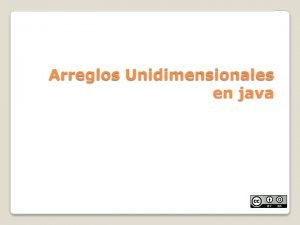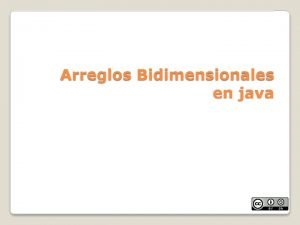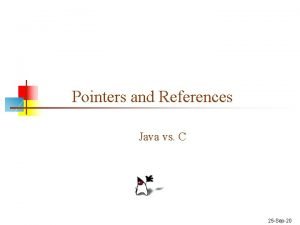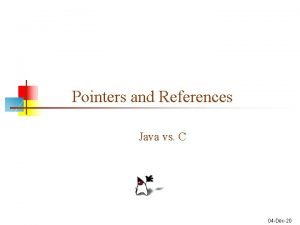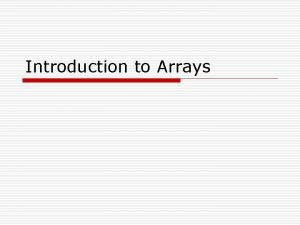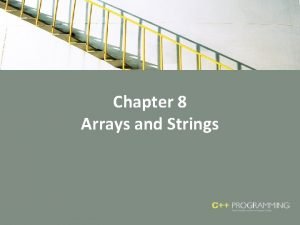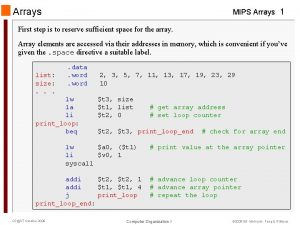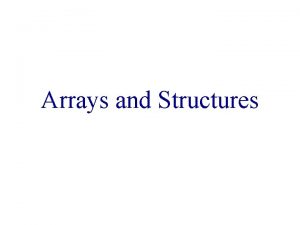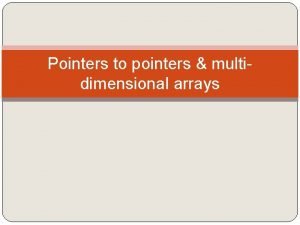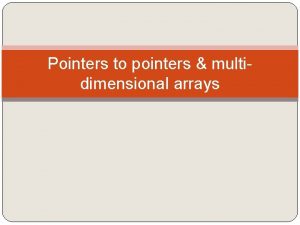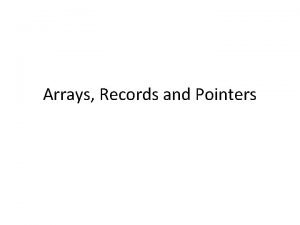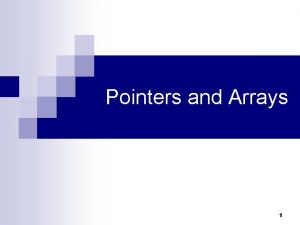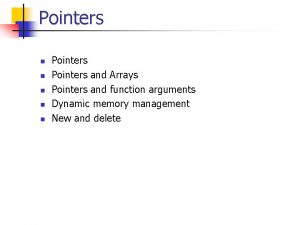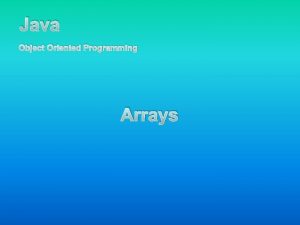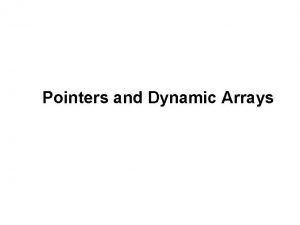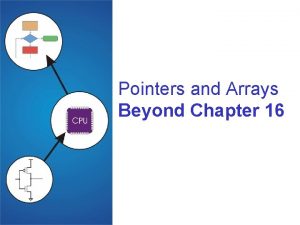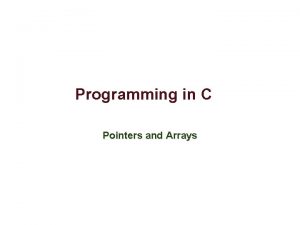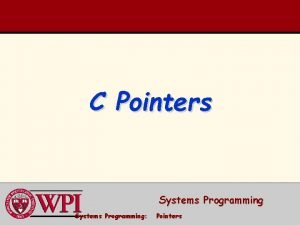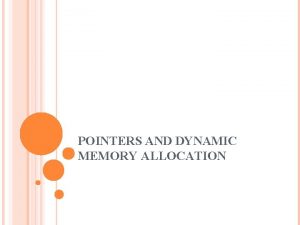C Arrays and Pointers In Java pointers are


![Example Code int x = 1, y = 2, z[10]; int *ip; // ip Example Code int x = 1, y = 2, z[10]; int *ip; // ip](https://slidetodoc.com/presentation_image/2ab1eb939c474f8f9cb7f35c64c2950d/image-3.jpg)
![Arrays and Pointers • We declare an array using [ ] in our declaration Arrays and Pointers • We declare an array using [ ] in our declaration](https://slidetodoc.com/presentation_image/2ab1eb939c474f8f9cb7f35c64c2950d/image-4.jpg)


![Array Example Using a Pointer int x[4] = {12, 20, 39, 43}, *y; y Array Example Using a Pointer int x[4] = {12, 20, 39, 43}, *y; y](https://slidetodoc.com/presentation_image/2ab1eb939c474f8f9cb7f35c64c2950d/image-7.jpg)


![More On Pointer Arithmetic • We can also perform subtraction on pointers int a[10] More On Pointer Arithmetic • We can also perform subtraction on pointers int a[10]](https://slidetodoc.com/presentation_image/2ab1eb939c474f8f9cb7f35c64c2950d/image-10.jpg)



![Example char *x[ ] = {"hello", "goodbye", "so long", "thanks for all the fish"}; Example char *x[ ] = {"hello", "goodbye", "so long", "thanks for all the fish"};](https://slidetodoc.com/presentation_image/2ab1eb939c474f8f9cb7f35c64c2950d/image-14.jpg)


- Slides: 16

C Arrays and Pointers • In Java, pointers are easy to deal with – In fact, there is little that can go wrong in Java since pointer access is done for you • the only exception is in passing an object to a method without knowing if the method will change the object or not (for instance, Strings cannot be changed in a method like concat) • In C, pointers are more challenging – You will need to know • when to use a pointer • when to dereference the pointer • when to pass an address of a variable rather than the variable itself • when to use pointer arithmetic to change the pointer • how to use pointers without making your programs unreadable – Basically, you have to learn how to not “shoot yourself in the foot” with pointers

The Basics • A pointer is merely an address of where a datum or structure is stored – all pointers are typed based on the type of entity that they point to – to declare a pointer, use * preceding the variable name as in int *x; • To set a pointer to a variable’s address use & before the variable as in x = &y; – & means “return the memory address of” – in this example, x will now point to y, that is, x stores y’s address • If you access x, you merely get the address • To get the value that x points to, use * as in *x – *x = *x + 1; will add 1 to y • * is known as the indirection (or dereferencing) operator because it requires a second access – that is, this is a form of indirect addressing
![Example Code int x 1 y 2 z10 int ip ip Example Code int x = 1, y = 2, z[10]; int *ip; // ip](https://slidetodoc.com/presentation_image/2ab1eb939c474f8f9cb7f35c64c2950d/image-3.jpg)
Example Code int x = 1, y = 2, z[10]; int *ip; // ip is a pointer to an int, so it can point to x, y, or an element of z ip = &x; y = *ip; *ip = 0; ip = &z[0]; // ip now points at the location where x is stored // set y equal to the value pointed to by ip, or y = x // now change the value that ip points to to 0, so now x = 0 // but notice that y is unchanged // now ip points at the first location in the array z *ip = *ip + 1; // the value that ip points to (z[0]) is incremented int x, *y, z, *q; x = 3; y = &x; printf("%dn", x); printf("%dn", y); printf("%dn", *y+1); printf("%dn", *(y+1)); z = *(&x); q = &*y; // y points to x // outputs 3 // outputs x’s address, will seem like a random number to us // outputs what y points to, or x (3) // outputs 4 (print out what y points to + 1) // this outputs the item after x in memory – what is it? // z equals 3 (what &x points to, which is x) // q points to 3 – note *& and &* cancel out
![Arrays and Pointers We declare an array using in our declaration Arrays and Pointers • We declare an array using [ ] in our declaration](https://slidetodoc.com/presentation_image/2ab1eb939c474f8f9cb7f35c64c2950d/image-4.jpg)
Arrays and Pointers • We declare an array using [ ] in our declaration following the variable name – int x[5]; // unlike Java, we can’t do int[ ] x; • You must include the size of the array in the [ ] when declaring unless you are also initializing the array to its starting values as in: – int x [ ] = {1, 2, 3, 4, 5}; – you can also include the size when initializing as long as the size is >= the number of items being initialized (in which case the remaining array elements are uninitialized) • As in Java – you access array elements just as in Java as in x[4] – array indices start at 0 – arrays can be passed as parameters, the type being received would be denoted as int x[ ] • Arrays in C are interesting because they are pointed to – the variable that you declare for the array is actually a pointer to the first array element • You can interact with the array elements either through pointers or by using [ ] • One of the intriguing features of pointers in C is the ability to manipulate the pointers through pointer arithmetic – a pointer is an int value, so we can add or subtract – this will be used for stepping through arrays rather than using array indices

Using Pointers with Arrays • Recall in an earlier example, we did • Notice that ip=ip+1 (or ip++) ip = &z[0]; moves the pointer 4 bytes • This sets our pointer to point at the instead of 1 to point at the next first element of the array location – In fact, z is a pointer as well and – The amounted added to the pointer we can access z[0] either using is based on the size of the array z[0], *ip, or *z element • 8 for an array of doubles • What about accessing z[1]? • 1 for an array of chars (strings) – We can do z[1] as usual, or we • 4 for an array of ints can add 1 to the location pointed to by ip or z, that is *(ip+1) or • We can declare our arrays using pointers instead of [ ] *(z+1) – notably, we might do this for our – While we can reset ip to be ip = formal parameters as this better ip+1, we cannot reset z to be z = describes what we are dealing with) z+1 – for instance, function 1(int *array) – adding 1 to ip will point to z[1], rather than function 1(int[ ] array) but if z = z + 1 were legal, we – We wouldn’t normally do this to would lose access to the first declare our arrays as the array’s array location since z is our pointer exists but not the array variable itself

Iterating Through the Array • Here we see two ways to iterate through an array, the usual way, but also a method using pointer arithmetic int j; for(j = 0; j < n; j++) a[j]++; int *pj; for(pj = a; pj < a + n; pj++) (*pj)++; • Let’s consider the code on the right: – pj is a pointer to an int – We start with pj pointing at a, that is, pj points to a[0] – The loop iterates while pj < a + n • pj is a pointer, so it is an address • a is a pointer to the beginning of an array of n elements so a + n is the size of the array • pj++ increments the pointer to point at the next element in the array • The instruction (*pj)++ says “take what pj points to and increment it” – NOTE: (*pj)++; increments what pj points to, *(pj++); increments the pointer to point at the next array element • what do each of these do? *pj++; ++*pj;
![Array Example Using a Pointer int x4 12 20 39 43 y y Array Example Using a Pointer int x[4] = {12, 20, 39, 43}, *y; y](https://slidetodoc.com/presentation_image/2ab1eb939c474f8f9cb7f35c64c2950d/image-7.jpg)
Array Example Using a Pointer int x[4] = {12, 20, 39, 43}, *y; y = &x[0]; // y points to the beginning of the array printf("%dn", x[0]); // outputs 12 printf("%dn", *y); // also outputs 12 printf("%dn", *y+1); // outputs 13 (12 + 1) printf("%dn", (*y)+1); // also outputs 13 printf("%dn", *(y+1)); // outputs x[1] or 20 y+=2; // y now points to x[2] printf("%dn", *y); // prints out 39 *y = 38; // changes x[2] to 38 printf("%dn", *y-1); // prints out x[2] - 1 or 37 *y++; // sets y to point at the next array element printf("%dn", *y); // outputs x[3] (43) (*y)++; // sets what y points to to be 1 greater printf("%dn", *y); // outputs the new value of x[3] (44)

Strings • There is no string type, we implement strings as arrays of chars – char str[10]; – char *str; length // str is an array of 10 chars or a string // str points to the beginning of a string of unspecified • There is a string. h library with numerous string functions – they all operate on arrays of chars and include: • strcpy(s 1, s 2) – copies s 2 into s 1 (including ‘�’ as last char) • strncpy(s 1, s 2, n) – same but only copies up to n chars of s 2 • strcmp(s 1, s 2) – returns a negative int if s 1 < s 2, 0 if s 1 = = s 2 and a positive int if s 1 > s 2 • strncmp(s 1, s 2, n) – same but only compares up to n chars • strcat(s 1, s 2) – concatenates s 2 onto s 1 (this changes s 1, but not s 2) • strncat(s 1, s 2, n) – same but only concatenates up to n chars • strlen(s 1) – returns the integer length of s 1 • strchr(s 1, ch) – return a pointer to the first occurrence of ch in s 1 (or NULL if ch is not present) • strrchr(s 1, ch) – same but the pointer points to the last occurrence of ch • strpbrk(s 1, s 2) – return a pointer to the first occurrence of any character in s 1 that matches a character in s 2 (or NULL if none are present) • strstr(s 1, s 2) – substring, return a pointer to the char in s 1 that starts a substring that matches s 2, or NULL if the substring is not present

Implementing Some of These int strlen(char *s) { int n; for(n = 0; *s != ‘�’; s++) n++; return n; } Notice in the second strcmp and second and third strcpy the use of pointers to iterate through the strings int strcmp(char *s, char *t) { int i; for(i=0; s[i] = = t[i]; i++) if(s[i] = = ‘�’) return 0; return s[i] – t[i]; } int strcmp(char *s, char *t) { for( ; *s = = *t; s++, t++) if(*s = = ‘�’) return 0; return *s - *t; } The conciseness of the last strcmp and strcpy make them hard to understand void strcpy(char *s, char *t) { int i = 0; while((s[i] = t[i]) != ‘�’) i++; } void strcpy(char *s, char *t) { while((*s = *t) != ‘�’) { s++; t++; } } void strcpy(char *s, char *t) { while((*s++ = *t++) != ‘�’); }
![More On Pointer Arithmetic We can also perform subtraction on pointers int a10 More On Pointer Arithmetic • We can also perform subtraction on pointers int a[10]](https://slidetodoc.com/presentation_image/2ab1eb939c474f8f9cb7f35c64c2950d/image-10.jpg)
More On Pointer Arithmetic • We can also perform subtraction on pointers int a[10] = {…}; int *ip; for(ip = &a[9]; ip >= a; ip--) … to a function the address pass • Here, we of the third element of an array (&a[2]) and use pointer subtraction to get to a[0] and a[1]) int a[3] = {…}; printf(“%d”, addem(&a[2])); Recall: a[0] = *a and a[i] = *(a + i) int addem(int *ip) { int temp; temp = *ip + *(ip – 1) + *(ip – 2); return temp; } If a is an array, and p = &a[0] then we can reference array elements as a[i], *(p+i), but we can also reference them as p[i] and *(a+i) – that is, a and p are both pointers to the array And can be dereferenced by * or by [ ]

Multidimensional Arrays • As in Java, C allows multidimensional arrays by using more [ ] – Example: int matrix[5][10]; • Some differences: – Because functions can be compiled separately, we must denote all but one dimension of a multiple dimensional array in a function’s parameter list • void afunction(int amatrix[ ][10]); – Because arrays are referenced through pointers, there are multiple ways to declare and access 2+ dimensional arrays • This will be more relevant when dealing with an array of strings (which is a 2 -D array) int a[10][20]; int *a[10]; int **a; *a[4] –first element of 5 th array element *a[9] –first element of 10 th array element **a –first element of a[0] int *a[3]; // array of 3 pointers int x[2] = {1, 2}; int y[3] = {3, 4, 5}; int z[4] = {6, 7, 8, 9}; *a = &x[0]; // a[0] points to x[0] *(a+1) = &y[0]; // a[1] points to y[0] *(a+2) = &z[0]; // a[2] points to z[0] // array a is a jagged array, it is not // rectangular, or of equal dimensions

Pointers to Pointers • As indicated in the last slide, we can have an array of arrays which is really an array of pointers or pointers to pointers – We may wish to use pointers to pointers outside of arrays as well, although it is more common that pointers to pointers represent array of pointers – Consider the following: int a; int *p; int **q; a = 10; p = &a; q = &p; printf(“%d”, **q); We dereference our pointer p with *p but we dereference our pointer to a pointer q with **q *q is actually p, so **q is a // outputs 10

Arrays of Strings Implementation • We could implement an array of strings as a 2 -D array of chars – char array[10]; • This has two disadvantages – All strings will be 10 chars long – Requires 2 nested for-loops for most operations such as string comparison or string copying, which can become complicated • Instead, we will implement our array of strings as an array of pointers – char *array[10]; • Each pointer points to one string – Follow the string through the pointer – Go to the next string using a for-loop – Because strcpy, strcmp, strlen all expect pointers, we can use these by passing an array element (since each array element is a pointer to a string)
![Example char x hello goodbye so long thanks for all the fish Example char *x[ ] = {"hello", "goodbye", "so long", "thanks for all the fish"};](https://slidetodoc.com/presentation_image/2ab1eb939c474f8f9cb7f35c64c2950d/image-14.jpg)
Example char *x[ ] = {"hello", "goodbye", "so long", "thanks for all the fish"}; // our array of strings x is a set of 4 pointers char *y; // let y be a pointer to a char so it can be used to move through a single string int i; for(i=0; i<4; i++) // iterate for each string in x { y = x[i]; // x[i] is an array, x is really a pointer, so this sets y to x’s starting addr. while(*y!='�') // while thing y points to is not the end of a string { printf("%c", *y); // print what y points to y++; // and go on to the next char in x } printf("n"); // separate strings in output with n } • Notice that if we had used char x[ ][ ] = {…}; then the storage space would have been 4 strings of length 23 (the length of the longest string) or 92 bytes instead of 42 bytes as it is above

Passing Arrays • When an array is passed to a function, what is being passed is a pointer to the array – In the formal parameter list, you can either specify the parameter as an array or a pointer int array[100]; … afunction(array); … void afunction(int *a) {…} or void afunction(int a[ ]) {…} • Because you can compile functions separately, the compiler must be able to “know” about an array being passed in to a function, so you must specify all (or most) of the definition: – The type and all dimensions except for the first int array[5][10][15]; … afunction(array); … void afunction(int a[ ][10][15]) {…} void afunction(int *a[10][15]) {…} void afunction(int a[5][10][15]) {…} void afunction(int **a[15]) {…} or or or etc

Some Additional Comments • In functions, do not do return p; where p is a pointer – Recall local variables are deallocated when the function ends • so whatever p is pointing to will no longer be available • but if you return the pointer, then you still are pointing at that memory location even though you no longer know what is there • We can declare a pointer to point to a void type, which means that the pointer can point to any type – However, this does require a cast before the pointer can be assigned • int x; float y; void *p; • p = (int *) &x; • p = (float *) &y; // p can point to either x or y // p can point to int x once the address is cast // or p can point to float y • Pointers that don’t currently point to anything have the special value NULL and can be tested as (p = = NULL) or (!p), and (p != NULL) or (p)
 Mikael ferm
Mikael ferm Parallel arrays python
Parallel arrays python Que es un arreglo unidimensional en java
Que es un arreglo unidimensional en java Arreglos bidimensionales java
Arreglos bidimensionales java & vs * in c
& vs * in c & vs * in c
& vs * in c What are pointers in java
What are pointers in java Dynamic arrays and amortized analysis
Dynamic arrays and amortized analysis Searching and sorting arrays in c++
Searching and sorting arrays in c++ Disadvantages of array
Disadvantages of array Array of arrays c++
Array of arrays c++ Parallel arrays
Parallel arrays 潘仁義
潘仁義 C++ parallel arrays
C++ parallel arrays Why do we need arrays?
Why do we need arrays? Arrays in mips
Arrays in mips Polynomial representation using arrays
Polynomial representation using arrays


